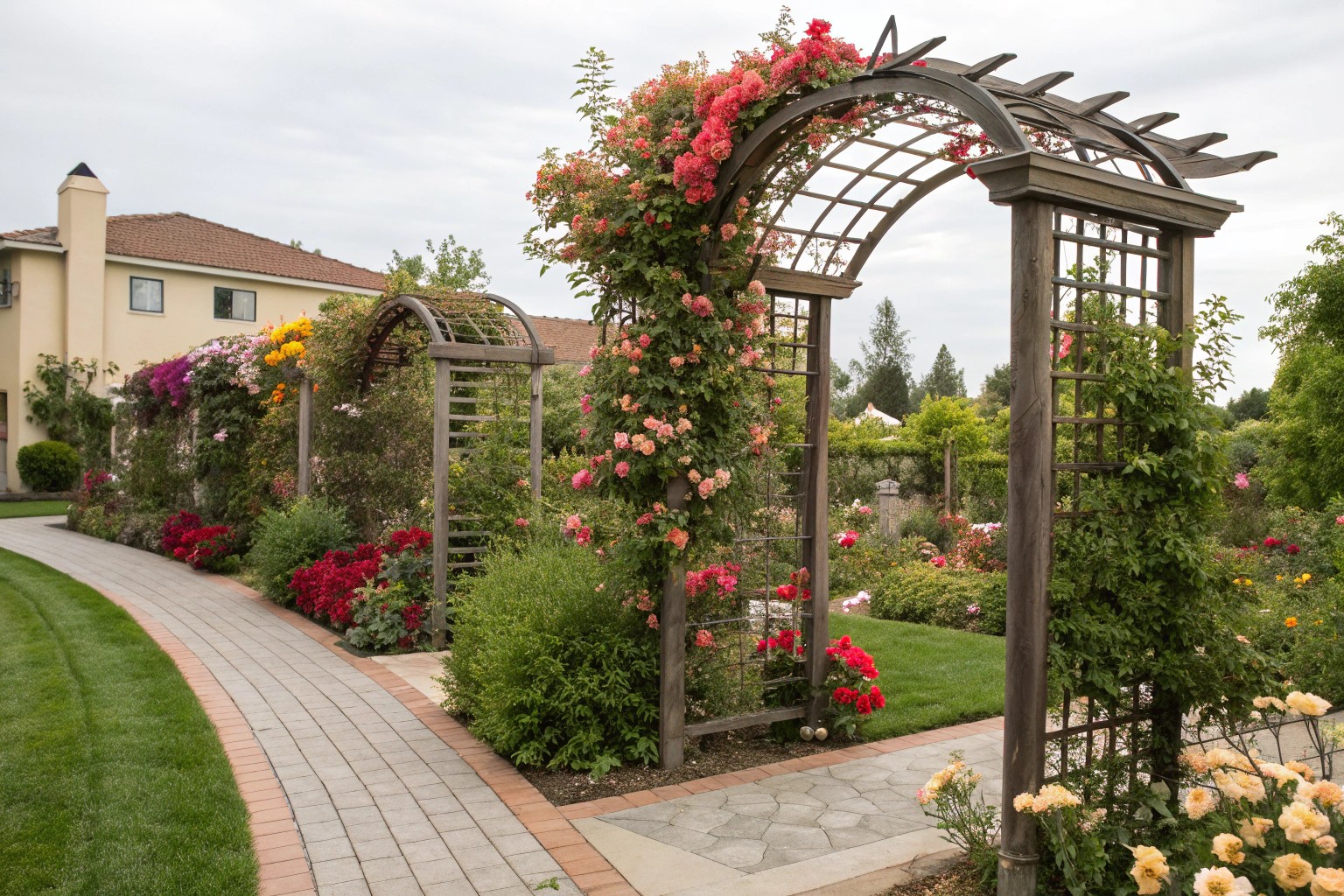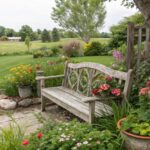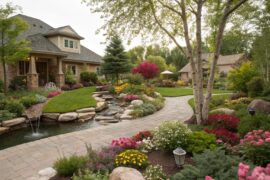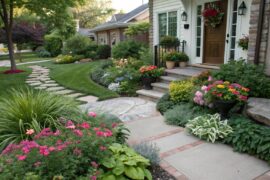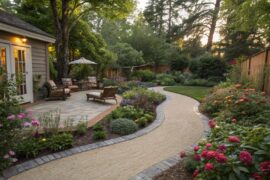When it comes to garden structures, trellises offer that perfect blend of function and beauty. While traditional wooden lattices have their place, there’s a special magic in creating trellises from unexpected materials. These unique structures not only support your climbing plants but tell stories, reduce waste, and become conversation pieces in their own right.
The Evolution of Trellises: From Garden Necessity to Design Statement
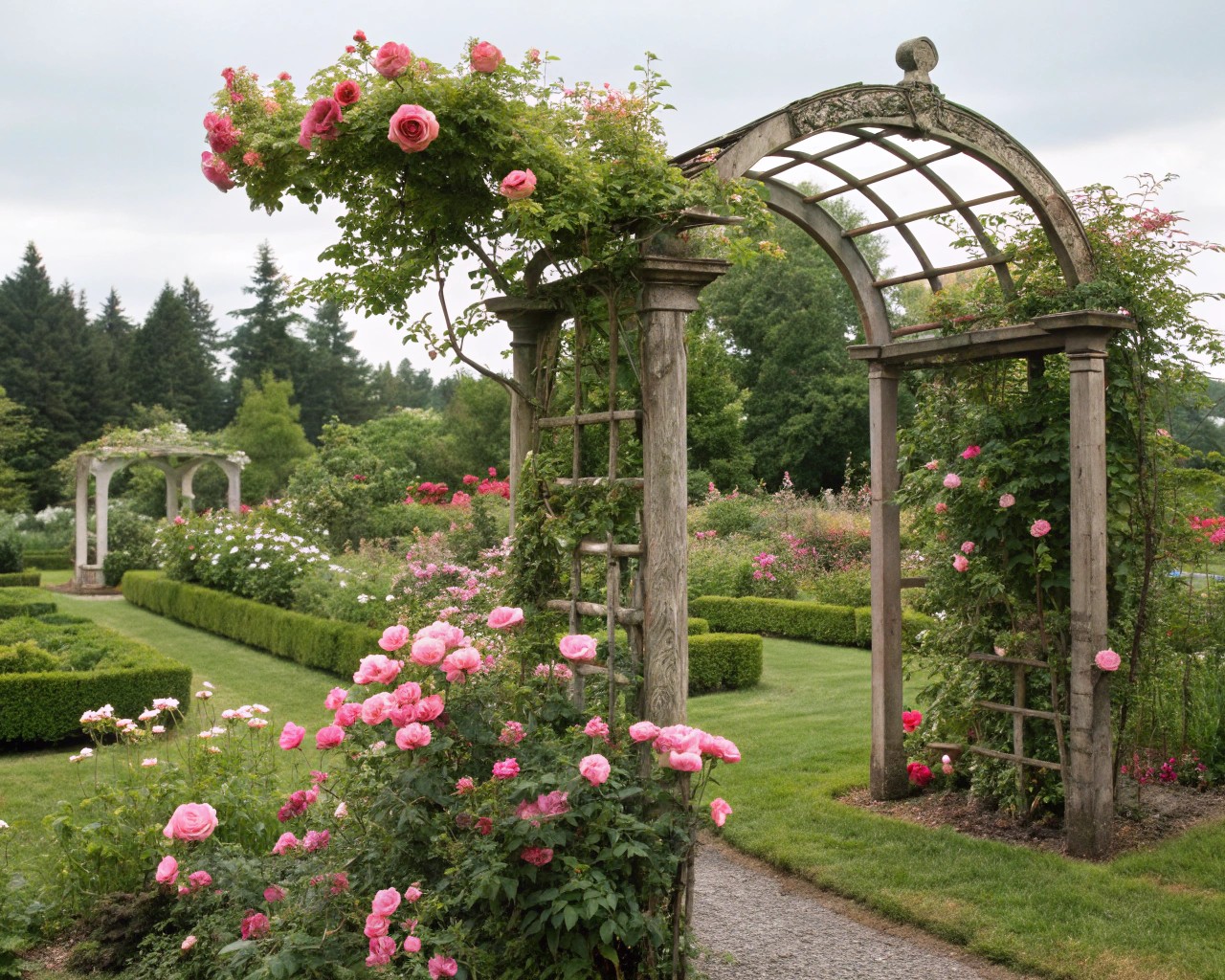
Trellises have come a long way from their humble beginnings. Originating in the 12th century, French farmers devised “trelliages” from wood and metal strips primarily to support growing plants. Their appeal grew significantly during King Louis XVI’s reign, notably with the lavish “Salon De Trelliage” showcased in the gardens of Versailles.
Today, trellises have transcended their purely functional origins. A pivotal moment occurred in 1905 when designer Elsie de Wolfe introduced the innovative “Trellis Room” at New York City’s Colony Club, revolutionizing interior design. Now, trellises are recognized not just outdoors but as architectural elements that contribute texture, depth, and character to both gardens and indoor environments.
Why Unconventional Materials Make Superior Trellises
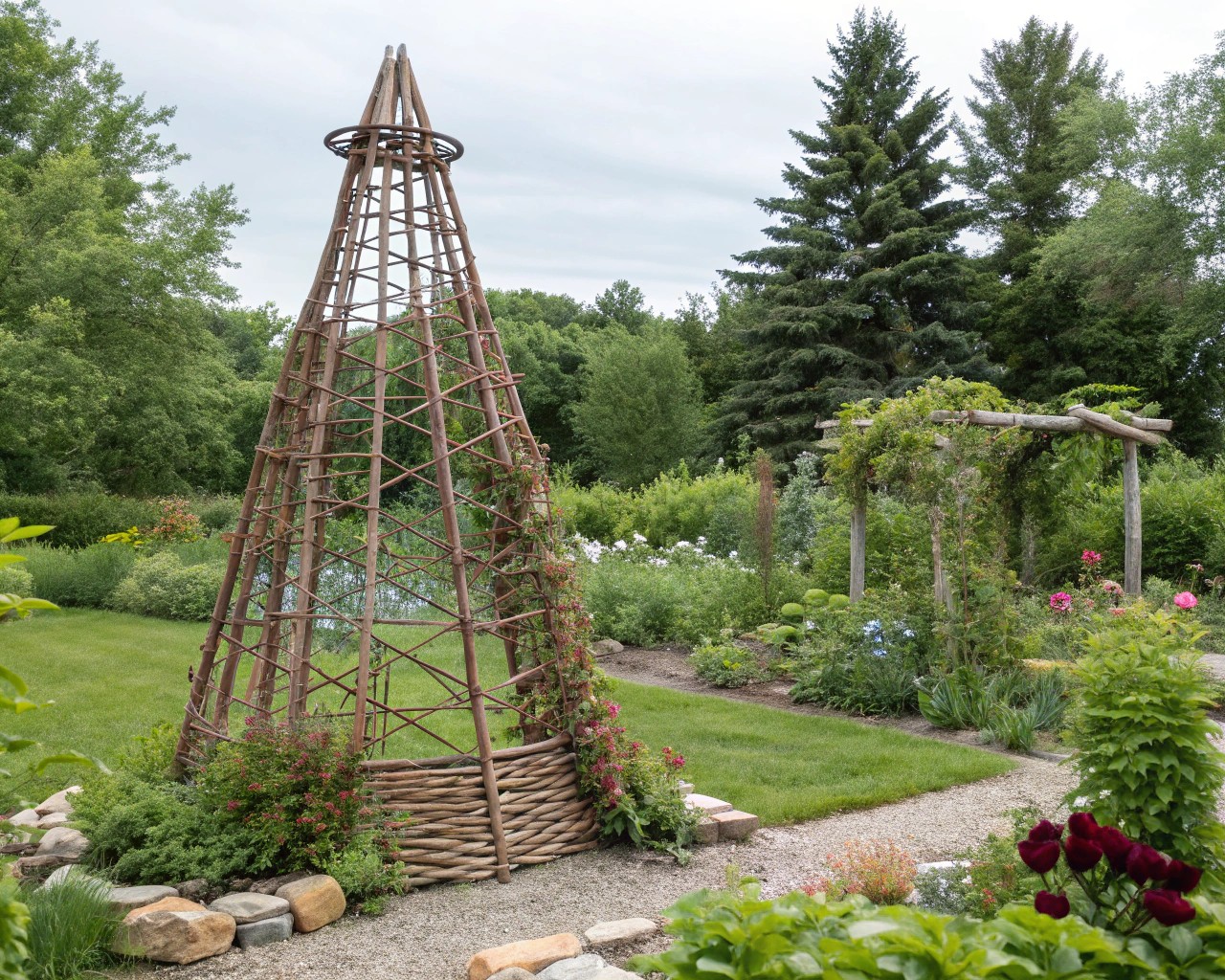
There are compelling reasons to consider unexpected materials for trellises, benefits I often share with clients:
Environmental Impact: Repurposing materials reduces landfill waste and minimizes your carbon footprint. An item potentially destined for the dumpster can become a garden centerpiece.
Cost-Effectiveness: Utilizing recycled materials can lead to significant savings compared to purchasing new trellises. We have successfully created stunning designs for clients at a fraction of standard retail costs.
Unique Aesthetic: Every recycled trellis possesses its own history. An old bicycle wheel or a vintage gate imparts a character that mass-produced options simply cannot replicate.
Practical Versatility: Many unconventional materials demonstrate surprising durability and adaptability suitable for various plants and spatial requirements.
Unexpected Trellis Materials That Deliver Stunning Results
From the Garage and Workshop
Bicycle Components: Old bicycle wheels are easily transformed into perfect circular trellises. Their spokes offer ideal attachment points for climbing plants such as roses, cucumbers, and squash. A particularly effective design involves mounting an old bike wheel rim on a broom handle, using jute rope to create vertical lines for peas and beans to ascend.
PVC Pipe: This inexpensive material allows for the creation of elegant geometric forms. Triangular or dome-shaped PVC trellises provide ample vertical space for vegetable growth while making a distinctive design statement.
Cattle Panels: These sturdy metal farm panels serve as cost-effective trellises that encourage vegetables to grow upwards, thereby maximizing valuable garden space.
From the Home

Old Ladders: Both wooden and metal ladders introduce instant vertical interest. The rungs provide natural support for vining plants, and they can be leaned against walls or fences for enhanced stability.
Window Frames: Salvaged windows, once the glass is removed, become excellent supports for climbing vines like star jasmine. We’ve observed beautiful installations where these frames create the charming illusion of “windows” peering into different garden sections.
Vintage Gates: Old iron gates can be repurposed as dramatic focal points that also support climbing plants. Their ornate designs are particularly complementary to cottage garden styles.
Bed Frames: Those ornate metal headboards perhaps gathering dust in your attic? They can be transformed into charming garden trellises, adding a touch of whimsy while supporting substantial plant growth.
Surprising Sources

Fishing Nets: In coastal regions, discarded fishing nets can be fashioned into remarkable large-scale trellises. Commercial fishing operations often dispose of damaged nets that gardeners can readily repurpose. One impressive example measured nearly 25 by 6 feet and successfully supported kabocha squash.
Medical Equipment: Old crutches serve as surprisingly effective trellises. After cutting off the bottoms, they can be angled into the ground for vines to climb alongside. Alternatively, the detached bottom parts can function as anchors for nylon climbing ropes.
Natural Materials: Foraged sticks gathered from your own garden can be lashed together with twine, creating rustic trellises ideal for sweet peas and morning glories. Thicker grapevine branches, when woven together and dried, form beautiful, natural structures.
DIY Projects: Turning Trash to Garden Treasure
Here are three project concepts I’ve implemented with clients, successfully transforming discarded items into garden highlights:
Project 1: Bicycle Wheel Trellis Tower
Materials Needed:
- 3-5 old bicycle wheels of similar size
- One 8′ metal pole (rebar or electrical conduit works well)
- Wire or zip ties
- Concrete mix
- Bucket for base
Steps:
1. Create a concrete base by setting the metal pole in the center of a bucket filled with concrete mix
2. Allow concrete to cure for 24-48 hours
3. Thread bicycle wheels onto the pole at varying heights, securing with wire or zip ties
4. Plant climbing plants around the base that will grow upward through the wheels
Client Success Story: For the Moreno family in Chicago, we created a bicycle wheel tower using wheels from their children’s outgrown bikes. The structure now supports moonflower vines that bloom dramatically in the evening. It serves as both a nostalgic reminder of childhood adventures and a gorgeous garden focal point.
Project 2: Recycled Trellis Using Jute Rope and Oak Barrel
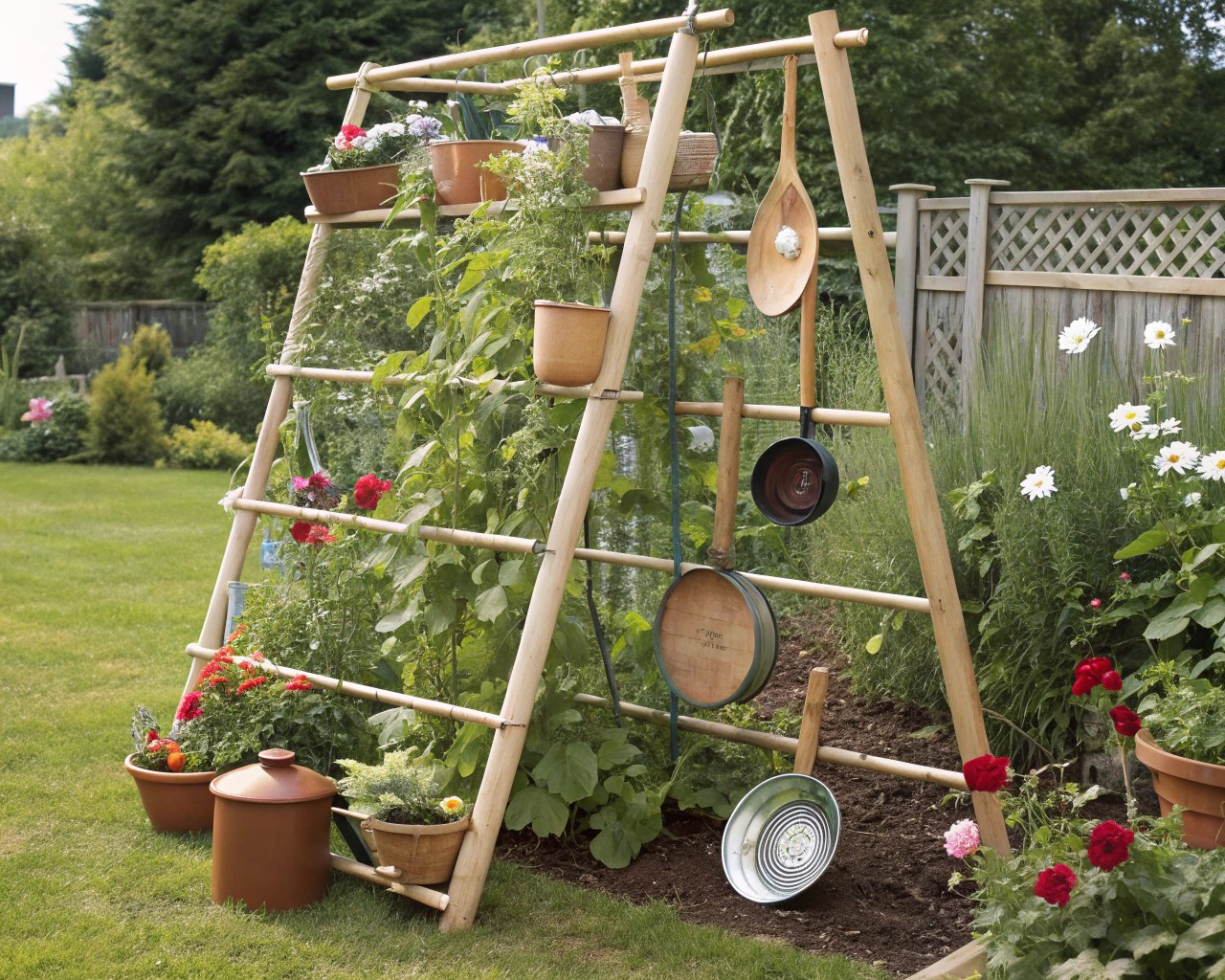
Materials Needed:
- Old bike wheel rim
- Jute rope
- Oak barrel or plastic pot
- Organic compost
- Broom handle
- Peas or bean seedlings
Steps:
1. Fill the oak barrel with organic compost
2. Drill holes around the border
3. Insert the broom handle through a drainage hole at the bottom for stability
4. Mount the bike wheel rim on top of the broom handle
5. Connect jute rope vertically from the wheel to the holes in the border
6. Plant seedlings behind the rope and train them to climb
This system ideally accommodates about 20 pea plants while leaving central space for additional plantings. The vertical growth strategy maximizes limited space and creates an attractive design element.
Project 3: V-Shaped Fence Trellis
Materials Needed:
- Wooden boards or metal strips
- Screws or nails
- Wire mesh or string
- Mounting hardware
Steps:
1. Create a V-shaped frame that widens at the top
2. Attach to an existing fence or wall with secure mounting hardware
3. Add wire mesh or horizontal/vertical strings for climbing support
4. Plant vines at the narrow base of the V
Design Insight: The V-shape design allows vines to naturally spread out as they climb, accommodating their growth pattern effectively. This structure offers visual appeal even before plants cover it, adding architectural interest to plain fences or walls.
Bringing Trellises Indoors: The New Interior Design Trend
In recent years, trellises have made a significant transition indoors, introducing depth, texture, and garden-inspired elegance to interior spaces.
Interior Trellis Applications
Wall Treatments: Applying lattice work to interior walls provides a sophisticated method for bringing outdoor elements inside. The repetition inherent in geometric patterns adds rhythm and movement to rooms.
Room Dividers: Trellises can function as stunning space dividers that permit light and air circulation while clearly defining separate areas. We have utilized salvaged window frames fitted with wire mesh inserts to craft semi-transparent dividers within open floor plans.
Ceiling Features: Overhead trellises draw attention upward, effectively disguising dated ceilings and contributing architectural interest.
Material Considerations for Indoor Trellises
| Material | Best Indoor Applications | Maintenance Level | Design Style |
|---|---|---|---|
| Wood | Traditional rooms, wall features | Medium – may need occasional dusting and sealing | Classic, cottage, traditional |
| Metal | Modern spaces, room dividers | Low – occasionally wipe clean | Contemporary, industrial, minimalist |
| FRP (Fiberglass Reinforced Plastic) | Sunrooms, high-humidity areas | Very low – washable and durable | Contemporary, transitional |
| Bamboo | Asian-inspired spaces, screens | Low – occasional dusting | Zen, tropical, bohemian |
| Repurposed items (windows, etc.) | Eclectic spaces, feature walls | Varies by material | Rustic, eclectic, vintage |
Design Principles for Successful Trellis Projects
Whether situated indoors or outdoors, adhering to these design considerations will help your unconventional trellis truly shine:
Scale and Proportion
The trellis should aim to complement, rather than overwhelm, its surroundings. Based on my experience, a frequent oversight is selecting a trellis that is undersized for the plants it’s intended to support. It’s important to remember that mature vines can easily reach weights of 50 pounds or more when laden with fruit or flowers.
Structural Integrity
Different materials possess varying weight-bearing capacities:
- Heavy-Duty Trellises (metal bed frames, gates): Suitable for supporting heavier vines like grapes, kiwi, and wisteria.
- Medium-Strength Trellises (fishing nets, bicycle wheels): Effective for plants such as cucumbers, tomatoes, and beans.
- Light-Duty Trellises (branch structures, plastic items): Best suited for morning glories, sweet peas, and other annual vines.
Anchoring for Stability
For vertical structures, it’s advisable to embed at least one-quarter of the trellis height securely into the ground. For free-standing structures, utilizing a concrete base or ecology blocks, which offer substantial anchoring force (3900-7800 lbf), is recommended.
After experiencing a particularly windy season during which several client installations were unfortunately lost, I now strongly advise securing all outdoor trellises as though they might face hurricane-force conditions. It is far simpler to over-engineer during the installation phase than to undertake rebuilding efforts after a storm.
Aesthetic Integration
Your trellis should enhance its environment through thoughtful consideration of:
- Color: Paint can serve to unify disparate materials. A collection of different metal objects, for instance, achieves cohesion when painted in the same color.
- Repetition: Employing multiples of the same repurposed item establishes an intentional design rather than appearing as a random assortment.
- Context: A rustic branch trellis integrates beautifully within a cottage garden setting but might seem incongruous in a more formal landscape.
Troubleshooting Common Trellis Challenges
Even the most creatively designed trellises can sometimes present challenges:
Problem: Trellis tilting under plant weight
Solution: Confirm proper anchoring. In softer soil conditions, deeper embedment is critical.
Problem: Plants outgrowing the trellis
Solution: Implement regular pruning to maintain balance. Train the main stems early on and remove excessive growth as needed.
Problem: Material deterioration
Solution: For natural materials, anticipate seasonal replacement or apply non-toxic preservatives. For metals, periodic rust treatment can considerably extend their lifespan.
Problem: Uneven plant growth
Solution: Adjust sun exposure if feasible, or employ strategic pruning to encourage more balanced growth. Occasionally, rotating potted trellises 180 degrees mid-season can help achieve greater evenness.
Seasonal Care for Long-Lasting Trellis Structures
Different seasons call for specific attention to maintain the integrity and appearance of your unconventional trellis:
Spring:
- Inspect all connections and anchoring points thoroughly before new growth commences.
- Clean surfaces using a gentle brush to remove accumulated winter debris.
- Apply preventative treatments, such as wood sealer or rust inhibitor, before plants begin to leaf out.
Summer:
- Monitor the weight distribution of plants and provide additional support ties if necessary.
- Gently redistribute vines if they appear to be clustering too heavily in one specific area.
- Trim any excessive growth that could potentially unbalance the structure.
Fall:
- Clean and carefully store more delicate trellises before the onset of harsh winter weather.
- Capture photographs of successful designs to serve as a reference for future projects.
- Collect fallen vines for composting instead of allowing them to decompose against the trellis structure.
Winter:
- Assess the structural integrity while plants are dormant and visibility is clear.
- Undertake necessary repairs or replace any damaged sections.
- Utilize this time for planning and constructing new trellises for the upcoming growing season.

